Physical Address
304 North Cardinal St.
Dorchester Center, MA 02124
Articular cartilage is a unique tissue with no vascular, nerve, or lymphatic supply. The lack of vascular and lymphatic circulation may be one of the reasons why articular cartilage has such a poor intrinsic capacity to heal. There is no inflammatory response to tissue damage unless there is involvement of subchondral bone in the damaged area. Subsequently, there will be no macrophage invasion to phagocytose and remove the damaged and devitalized tissue and, furthermore, no migration of cells with repair capacity into the damaged area. The chondrocyte itself, encapsulated in its own matrix, is incapable of migrating and repopulating the damaged area.
Chondral injuries that penetrate down to subchondral bone will not heal but may progress to osteoarthritis over time by enzymatic degradation and mechanical wear. Osteochondral injuries that penetrate subchondral bone into trabecular bone with bleeding will result in inflammatory repair tissue filling the lesion with fibrocartilage produced by mesenchymal stem cells or fibroblasts. Unfortunately, the quality of the fibrocartilage repair tissue has been shown to not be able to withstand mechanical wear over time, and the fibrocartilage may degenerate and the lesion progress to osteoarthritis.
Good results can be achieved with treatment of severe osteoarthritis of the knee by total joint replacement in older patients. However, this treatment exposes the patients to an increasing risk of potentially serious complications and also has a limited duration of life, finally demanding a revision surgery. Total knee arthroplasty burns the bridges to any other treatment options and is considered the last treatment option, indicated only for severe cases in elderly patients. In young and middle-aged patients, however, there is no optimal treatment for chondral injuries. The spectrum of treatment alternatives for articular cartilage defects in young and middle-aged patients can range from simple lavage and débridement, drilling, microfracturing, and abrasion to osteochondral grafting and autologous chondrocyte implantation (ACI).
The optimal healing of an articular cartilage injury should consist of regeneration with tissue identical to hyaline cartilage; however, repair of chondral injury involves filling with tissue not identical to hyaline cartilage (ie, fibrocartilage). The repair tissue should be able to fill and seal off the defective area with good adhesion to subchondral bone and complete integration to surrounding cartilage. It should be able to withstand mechanical wear over time and gradually be included in the natural turnover of normal cartilage, thus providing a variable duration of symptomatic relief.
The functional unit of articular cartilage includes not only the different layers of cartilage but also subchondral and trabecular bone. Any treatment technique that interferes with subchondral and trabecular bone may not be able to restore the functional unit of cartilage, especially its shock-absorbing function.
Techniques that affect the subchondral bone plate include abrasion, arthroplasty, multiple drilling, and microfracture. All these techniques may result in stiffening of subchondral and trabecular bone and thereby promote osteophytes' formation underneath the repair tissue. Osteochondral grafting may affect the subchondral and trabecular bone as the osseous part of the plug has to undergo resorption, revascularization, remodeling, and healing to the surrounding bone. Periosteal and perichondrial grafting also affect subchondral bone by drilling and abrading the subchondral bone plate.
Chondrocyte implantation does not violate subchondral or trabecular bone. On the contrary, for success with this technique, bleeding from subchondral bone should be avoided so that fibroblasts or stem cells are not introduced and result in fibroblastic repair tissue.
In 1965 Smith was successful in isolating and growing chondrocytes in culture for the first time. Epiphyseal chondrocytes grown in culture were injected into tibial articular defects in the rabbit knee but did not show any significant repair.
In 1982, experimental work started at the Hospital for Joint Diseases–Orthopedic Institute in New York to design an experimental rabbit model using articular chondrocytes isolated and grown in culture for implantation into a defect made in the patella and covered with a periosteal flap. The idea was to use articular chondrocytes because they are the only cells committed to form hyaline cartilage.
The initial results of ACI in this rabbit model were presented in 1984 and showed hyaline-like cartilage filling 80% of the patellar defect. No significant filling was seen in the control side, where the defect was treated with periosteal cover, but no cells.
Since 1984, extensive animal studies have been ongoing at the University of Göteborg, Sweden. The results from New York were confirmed and improved.
In 1985, work started on transferring the cell-culturing technique to human chondrocytes, and in 1987 the first ACI (or “transplantation,” as first named) was performed in the human knee at the Department of Orthopaedics, University of Göteborg, after approval by the Ethical Committee of the Medical Faculty of the University of Göteborg ( Fig. 29.1 ).
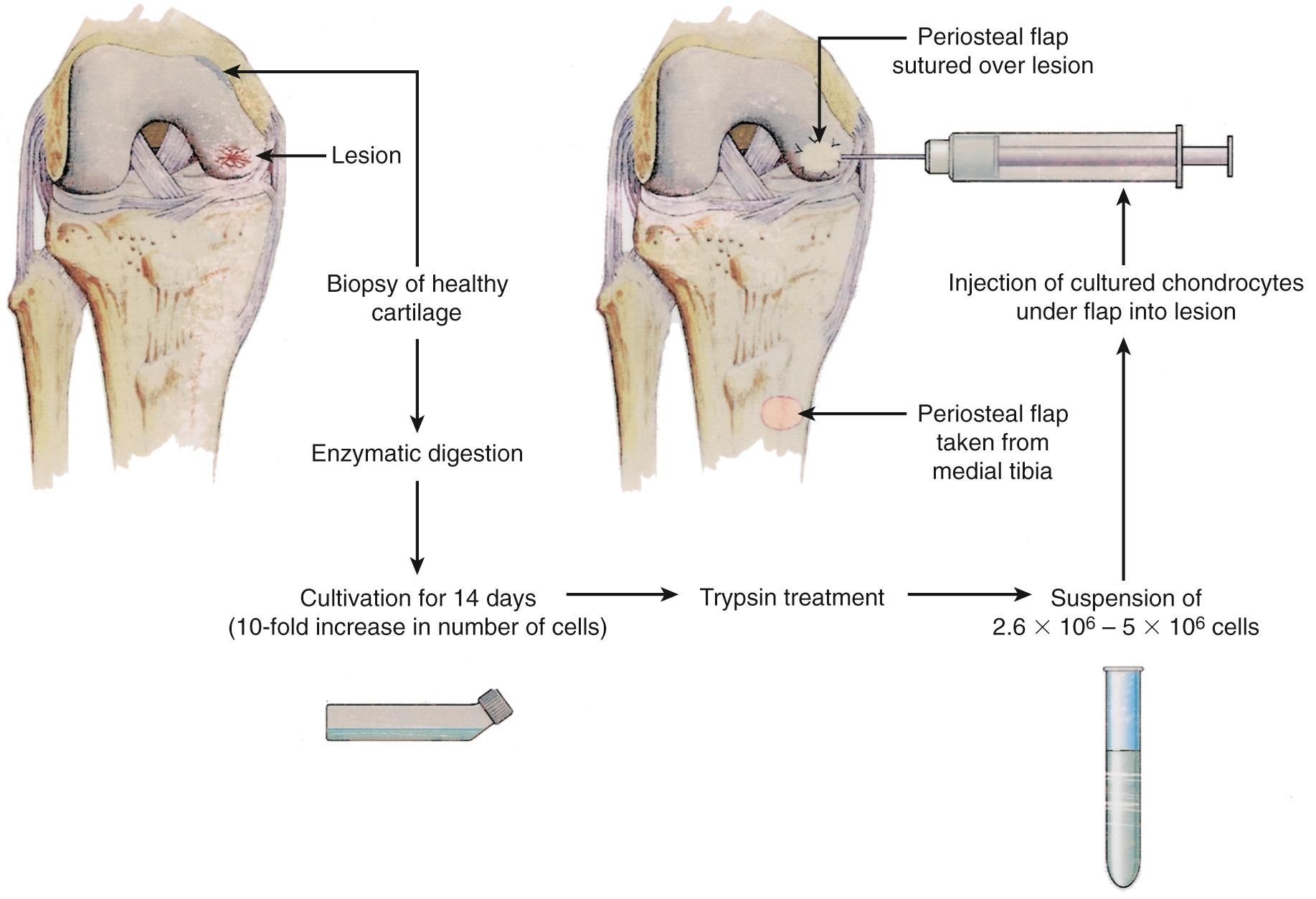
A pilot study of 23 patients with 39 months' follow-up reported in the New England Journal of Medicine in October 1994 showed that of the 16 patients who underwent femoral condyle procedures, 14 had a good or excellent result. Eleven of 15 biopsy specimens showed hyaline-like cartilage. Of the seven patients who underwent ACI of the patella, however, only two good or excellent results were achieved, and one biopsy specimen showed hyaline-like cartilage.
Since 1987, more than 1600 patients have been operated on in Gothenburg, Sweden, and since 1995, more than 400 surgeons have performed ACI on more than 25,000 patients outside Sweden.
The clinical results from Sweden have been reported at the American Academy of Orthopaedic Surgeons in 1996, 1997, 1998, 2000, 2001, 2002, 2003, and 2004, while the long-term results of 10 to 20 years after the ACI were first presented at the International Cartilage Research Society (ICRS) meeting in 2009.
ACI is indicated in patients between 15 and 55 years old with symptomatic, full-thickness, Outerbridge or ICRS grade III to IV cartilage injuries of the knee with a diameter larger than 10 mm up to an area of 10 to 16 cm 2 ( Fig. 29.2 ). The location of the defect should be on the femoral or patellar articular surface and should be accessible for implantation via open arthrotomy. Only grade I to II Outerbridge or ICRS classification changes on the reciprocal articular surface should be included.
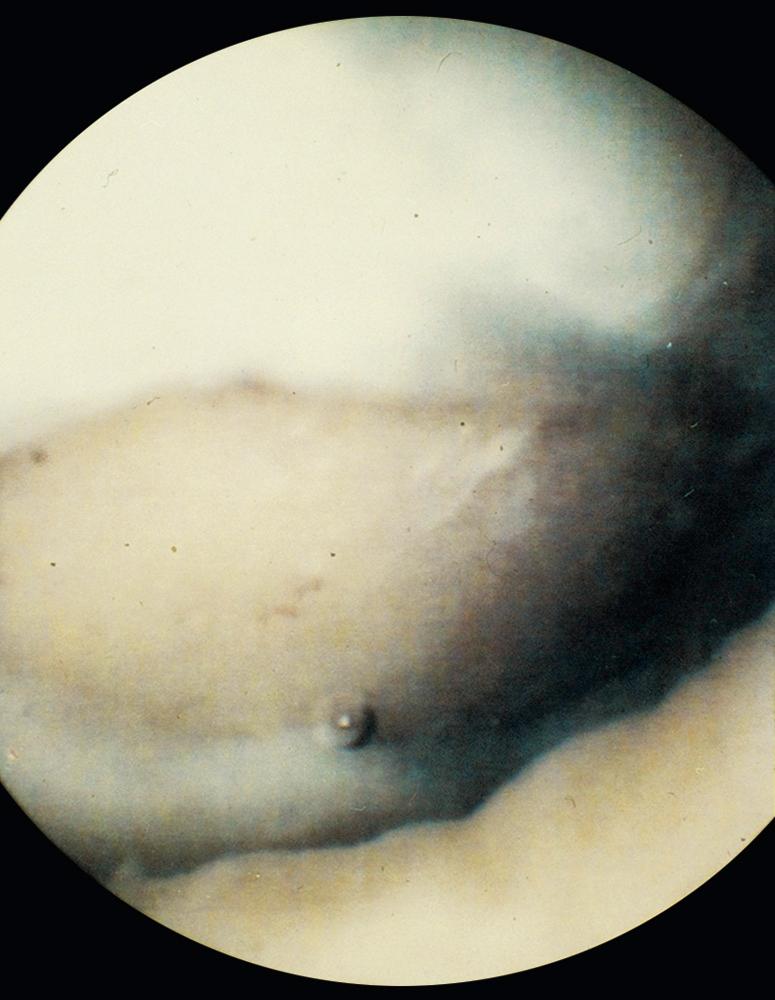
Osteochondritis dissecans of the medial or lateral femoral condyles with an unstable fragment, separated but attached flap, or empty bed is also an indication for ACI ( Fig. 29.3 ).
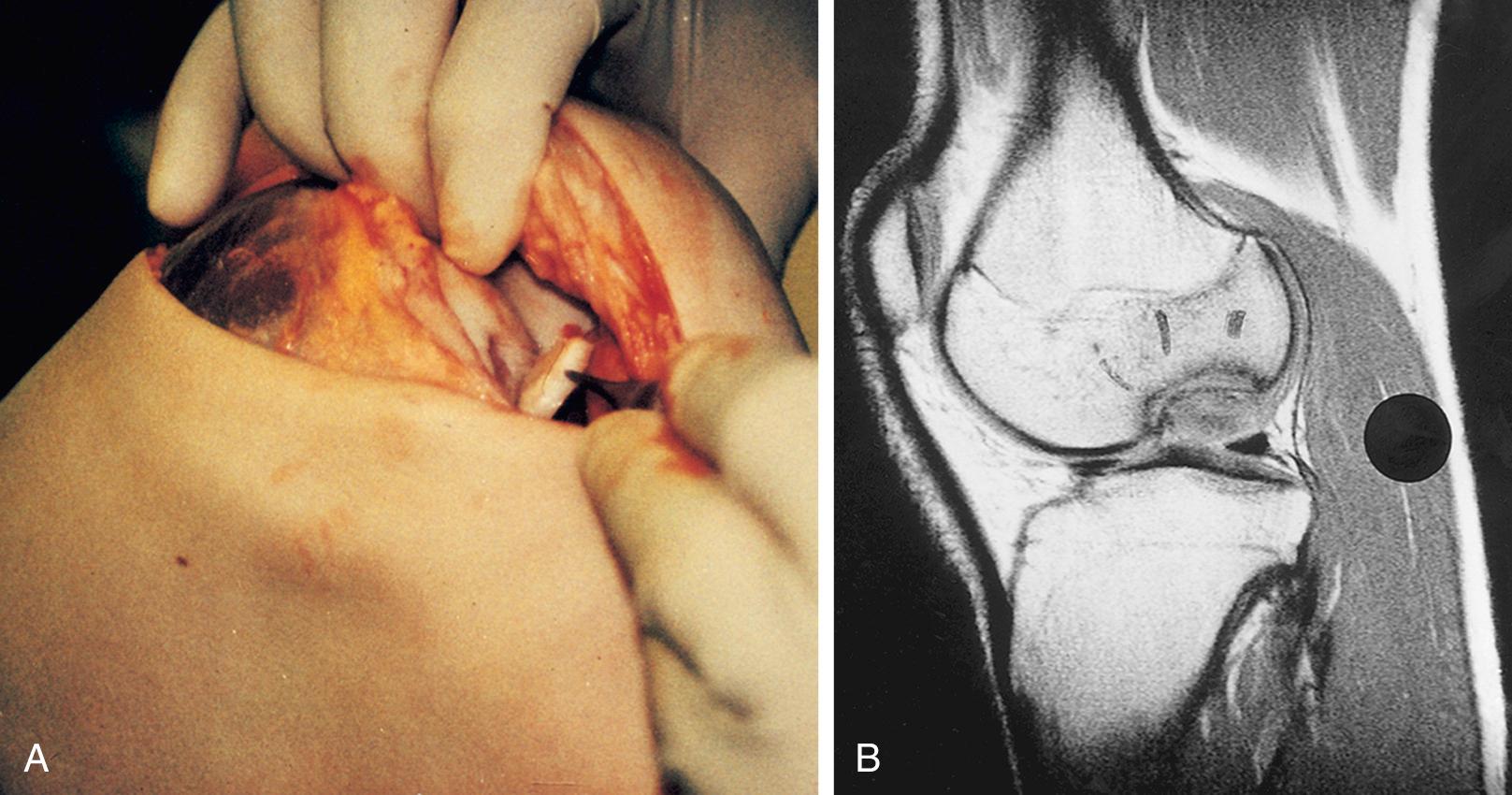
Bipolar chondral injuries (ie, osteoarthritis) are undergoing investigational studies and could be considered a salvage procedure or a relative indication at present. A recent long-term follow-up study shows good results 10 to 20 years after the implantation, even for large bipolar lesions, where ACI has been performed as a salvage procedure. There is evidence to support that ACI is indicated even for large bipolar lesions, delaying or even postponing the total knee arthroplasty. A definite decision regarding the indication is made during arthroscopic evaluation.
A thorough history of symptoms, trauma, or repetitive loading is important, as well as a careful record of previous surgery. Clinical examination, including signs of local tenderness, swelling, range of motion, and crepitation, is performed.
Varus and valgus deformities are assessed, and patella malalignment, maltracking, or instability is evaluated. Clinical testing of ligament instability is performed.
An understanding of the optimal environment for survival of the repair tissue in the short and long term is of utmost importance. Varus or valgus malalignment should be evaluated on standing x-ray films of the knee in the extended position and 45 degrees of knee flexion. Additional information could be achieved through examining the hip, knee, and ankle axis on long, standing x-ray films. Varus or valgus deformity should be corrected. Magnetic resonance imaging (MRI) could be helpful to evaluate the articular cartilage injury and condition of the subchondral bone in more detail, as well as the status of the menisci. Previous meniscus surgery should be assessed, and after total or subtotal meniscectomy, meniscal transplantation should be considered.
Instability should be evaluated clinically and any instability should be corrected. Osseous defects deeper than 8 to 10 mm should be considered for autologous bone grafting and chondrocyte implantation. MRI could be a helpful tool to evaluate any bone pathology.
Under general or spinal anesthesia, complete stability testing of the knee is performed and the results compared with those on the healthy side. A complete examination of the knee joint should be performed, including visualization and probing of the articular cartilage surfaces, synovial lining, menisci, and cruciate ligaments, and the presence of any fragment or loose body should be identified. Undiagnosed pathology may be critical to the outcome of surgery. The cartilage injury is visualized, probed, and assessed for depth, size, and location. The opposing articular surface should be assessed and should be normal or have only fibrillation or superficial fissuring (Outerbridge or ICRS grade I to grade II). The defect should be evaluated regarding containment and shouldering. An uncontained lesion extends into the synovial lining of the joint. It could be unilateral or bilateral, for example, extending from the synovial lining of the articular surface of the medial femoral condyle into the synovial lining of the intercondylar notch ( Fig. 29.4 ).

A shouldered defect is a defect surrounded by normal cartilage in which the bone in the center of the defect is not in contact with the opposing articular surface. An unshouldered defect is so large that in a weight-bearing position the subchondral bone in the center of the defect is in contact with the opposing articular surface ( Fig. 29.5 ). During arthroscopy, the proposed implantation is evaluated regarding different possibilities of the surgical approach, the intended amount of débridement, the extent of shouldering, containment of the defect, and so on.

Meniscal lesions should be treated at this time, but only after harvesting cartilage for cell culture. Cartilage fragments and loose bodies should be removed before harvesting the cartilage.
No or only gentle débridement of the injury should be performed at this time. When the specifics of the indication have been fulfilled, cartilage is harvested from the upper medial or upper lateral femoral condyle on minor weight-bearing areas ( Fig. 29.6 ). It could also be harvested from the intercondylar notch. In 98% of our cases, cartilage is harvested from the upper medial femoral condyle. With a curette, three to four slices of cartilage 3 to 4–10 mm should be taken down to subchondral bone on the upper medial femoral condyle. Approximately 200 to 300 mg of articular cartilage is required for enzymatic digestion and cell culturing. The harvesting area should extend to the synovial lining to allow fibrous as well as synovial ingrowth for covering the harvest area. In more than 2000 patients who have had cartilage removed for cell culturing, no complications or late symptoms have occurred from the donor site. Optimal harvesting of cartilage is of greatest importance for the success of cell culturing, and optimal cell quality is necessary for the best possible result of this procedure.
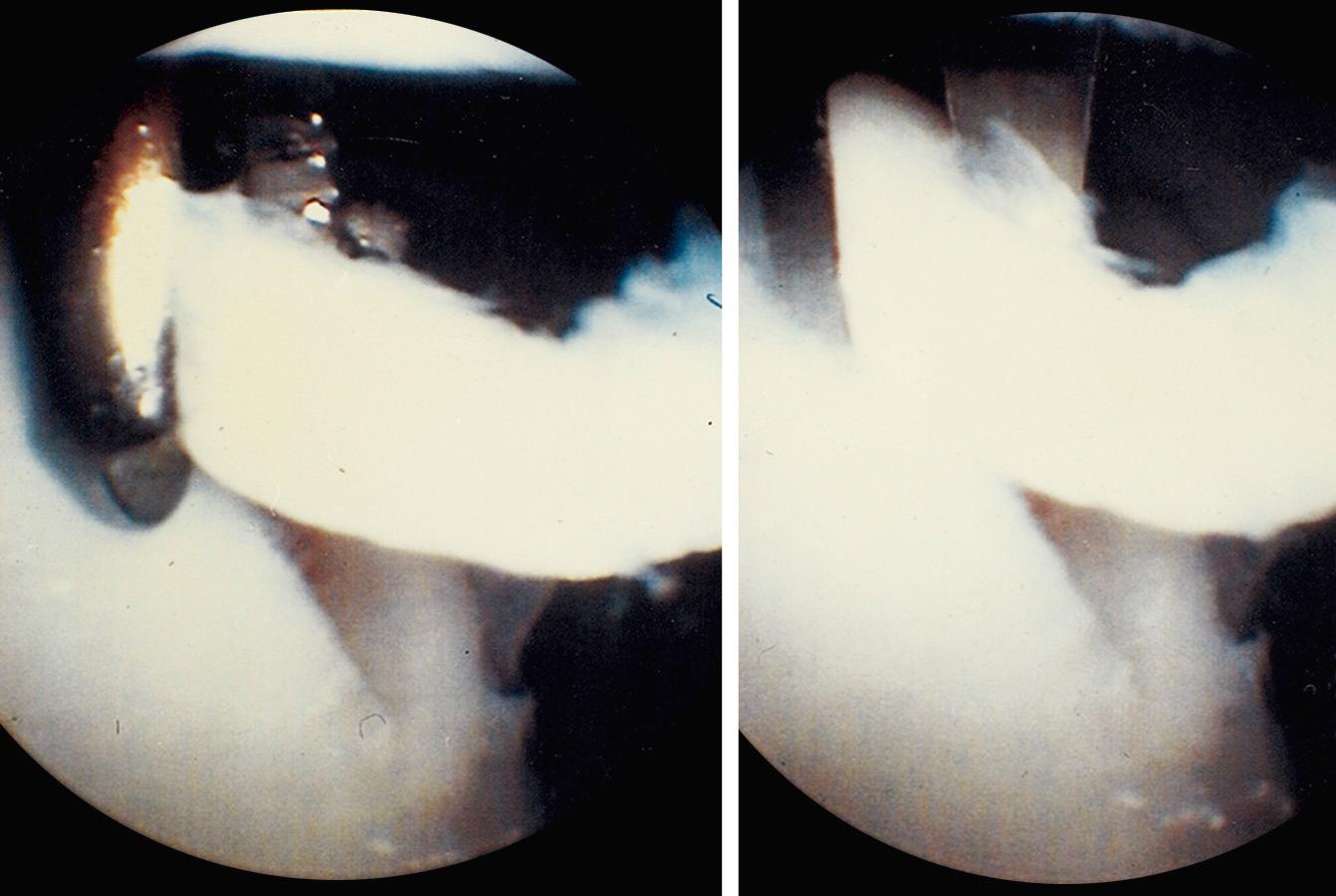
The retrieved cartilage is transferred to the cell culture lab in a sterile tube containing 0.9% NaCl. Upon the arrival, the cartilage is mechanically minced into smaller pieces (1 mm of diameter) and washed in medium supplemented with antibiotics (gentamicin sulfate, amphotericin B, L-ascorbic acid, and glutamine). Then it is subjected to overnight collagenase digestion, allowing isolation of the chondrocytes. The chondrocytes are then cultured in DMEM/F12 (Dulbecco's Modified Eagle Medium) with 10% autologous serum supplement and antibiotics. Primary cultures are performed in 25 cm 2 flasks incubated in 7% CO 2 in air at 37°C. After 1 week, the cells are trypsinized and passed into bigger culture flasks (75 cm 2 ), where they are cultured for an additional week. Two weeks after the culture begins, the cells are trypsinized again, washed, counted, and resuspended in 0.3 to 0.4 mL of implantation medium, in a tuberculin syringe, to a treatment density of 30 million cells/mL. A second surgery is performed for the implantation of the cells into the cartilage defect area.
The patient is placed under general or spinal anesthesia. With a tourniquet-controlled bloodless field, a minor parapatellar incision is made. The joint is opened and the injury assessed. For a good surgical technique, it is important to obtain good access to the defect, and the arthrotomy might need to be adjusted accordingly ( Fig. 29.7 ). The patella may have to be dislocated in the case of implantation to multiple femoral or patellar lesions.
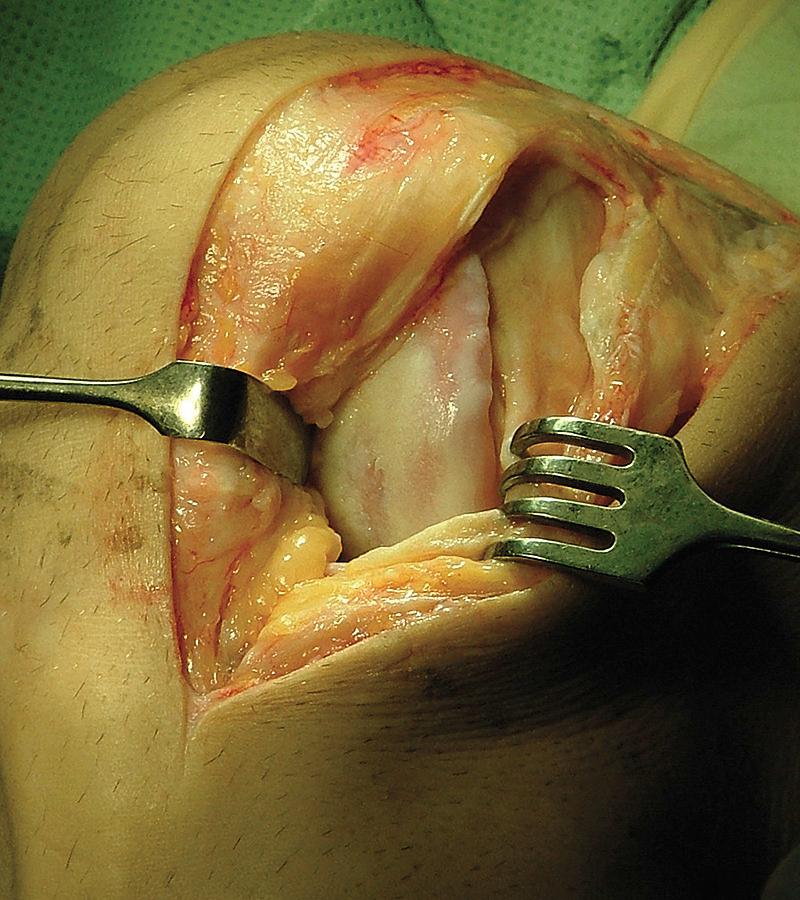
Clinical and radiological assessment has to be performed prior to the surgery, revealing a potential indication for a realignment procedure. A realignment procedure is then scheduled in patients with patella lesions and patellofemoral malalignment or instability. Tibial or femoral osteotomies are also performed when needed, in cases of excessive varus or valgus deformity, for the protection of the implanted area. Corrective operations (osteotomy, reconstruction of extensor mechanism, anterior cruciate ligament [ACL] reconstruction), were performed before the implantation of the cells. In case of tibial osteotomy, medial transfer of the tibial tuberosity, or ACL graft fixation, the fixation is performed at the end of the procedure before the implantation of the cells.
The cartilage lesion area is assessed, incised, and debrided with a curette down to the subchondral bone and until reaching healthy cartilage in the periphery of the defect. Radical excision is the key to success. The resulting lesions should be as circular or oval as possible. If the lesion is not contained by healthy cartilage, it is better to leave a 3- to 4-mm rim of acceptable cartilage than to have the lesion border bone or synovium. Gentle débridement of the excised area is performed down to subchondral bone but without causing any bleeding. If bleeding occurs, an epinephrine sponge or a drop of fibrin glue can stop it. The excised defect is then measured in its longest diameter and longest perpendicular diameter. The defect should be shaped as geometrically as possible. A template of sterile aluminum foil or paper is used to model the exact size of the defect ( Fig. 29.8 ).
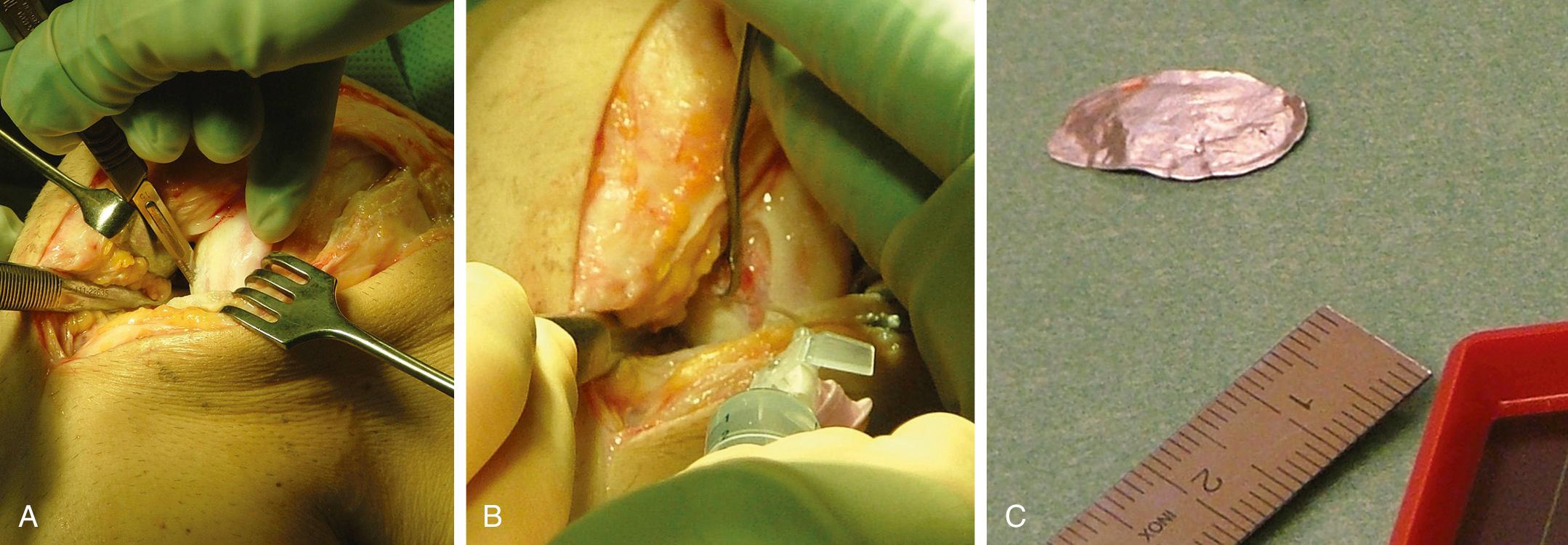
Through a separate incision on the upper medial aspect of the tibia below the pes anserinus, the periosteum is dissected free of fascia, fat, and fibrous tissue. Even passing vessels should be dissected off the flap. Measure the intended periosteal flap, or use the template to create the exact size and form. Oversize the periosteal flap by adding 1 to 2 mm to the periphery of the intended flap. Incise the periosteum and use a sharp elevator to remove the periosteal flap. Use small movements to avoid rifts in the periosteum ( Fig. 29.9 ). Mark the side of the periosteum to be able to identify the cambium layer. Saline is used to keep the periosteal flap moist. The periosteal flap should be as thin as possible and transparent to achieve more volume in the defect and allow the cells to spread and expand. The thinner the periosteal flap, the less risk for hypertrophy, fibrillation, or other complications.

Anchor the periosteal flap in four corners with the cambium layer facing the inside of the bone of the defect. Then adapt the periosteum to the surrounding cartilage by placing 6-0 resorbable suture at 4- to 6-mm intervals. Insert the suture to a depth of at least 5 to 6 mm to avoid cutting the cartilage. The intervals between the suture are sealed with fibrin glue. An opening in the upper part of the defect is left for injection of the cells.
Before injecting the cells, check that there is no leakage by introducing a soft catheter with a syringe into the defect. Inject saline slowly into the defect and check for any leakage. Then aspirate the saline and inject the cells into the defect, starting distally and withdrawing the syringe proximally as the cells are injected. Close the injection site with suture and fibrin glue ( Fig. 29.10 ).
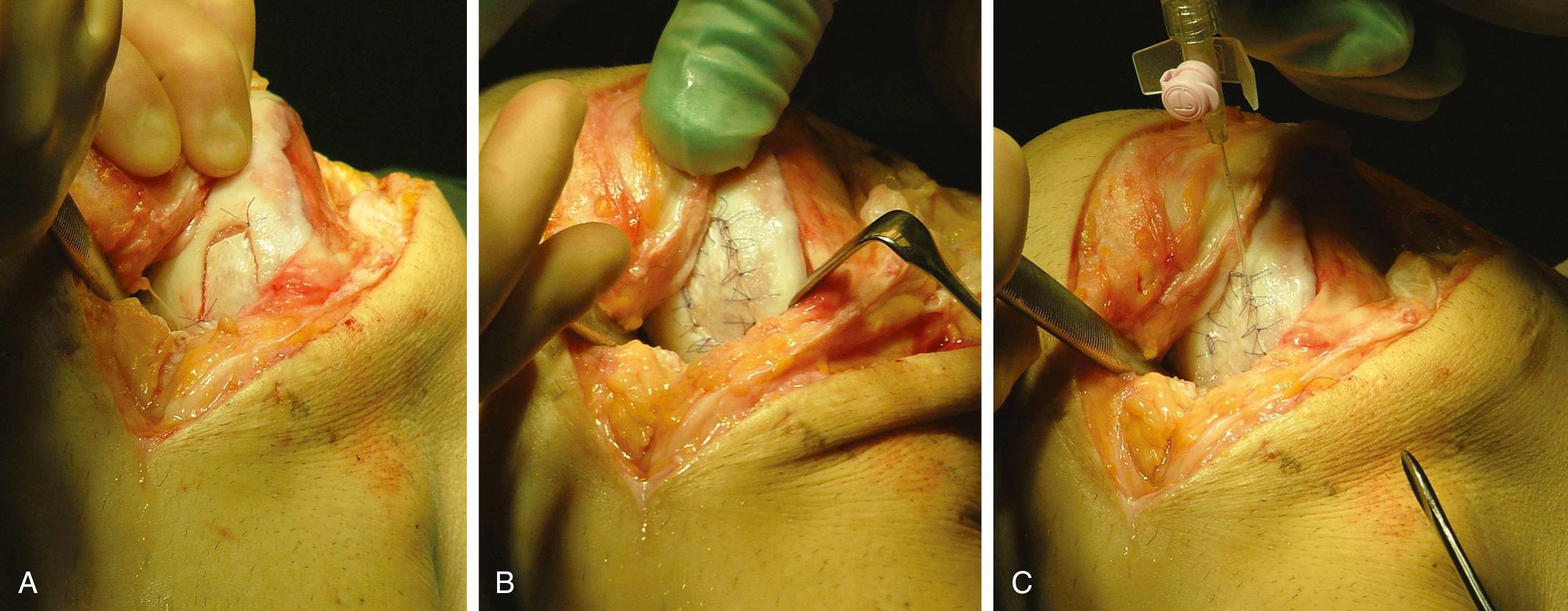
One surgical technique uses collagen I-III scaffold and Hyalograft as alternatives to the periosteal flap. Colagen I-III scaffold and Hyalograft have been used in our clinic since 2005. When using collagen I-III the sizing is important. Use the template to cut the scaffold as you would do for the periosteum in the first generation ACI, then inject the cell suspension on the rough surface intended to face the subchondral bone.
When treating osteochondritis dissecans by ACI, one must be attentive to the depth of the defect. If the bony defect is shallower than 6 to 8 mm, the lesion is treated the same way as a chondral lesion. Gently débride the sclerotic bottom of the defect, but be careful to not cause bleeding. The cartilage is incised and débrided to vertical edges of healthy cartilage. Cover the defect with a periosteal flap, seal, and check for leakage. Then implant the chondrocytes and close the last opening.
If the bony defect is deeper than 6 to 8 mm, ACI is not enough, and concomitant autologous bone grafting is needed (“sandwich technique”). Start by abrading the sclerotic bottom of the defect to spongy bone and undercut the subchondral bone plate. Use a 2-mm bur and drill multiple holes into the spongy bone. The cartilage is débrided to healthy cartilage with vertical edges. Then harvest cancellous bone for grafting of the bony defect. If the bony defect is small, use bone from the tibial or femoral condyle, but if the defect is larger, bone has to be harvested from the iliac crest. Pack the bone from the bottom up and try to shape the bone graft to the contour of the condyle.
Harvest a periosteal flap to cover the bone graft at the level of subchondral bone, with the cambium layer facing the joint. Anchor it with horizontal or mattress sutures placed into the cartilage or through small drill holes in the subchondral bone plate, and use fibrin glue under the flap for fixation to the bone graft. This technique will avoid bleeding into the cartilage defect. Another periosteal flap is harvested and sutured to the cartilage edges, with the cambium layer facing the defect. Use fibrin glue to seal the intervals between the sutures. Test for a watertight seal with a gentle saline injection. If no leakage is present, aspirate the saline and inject the chondrocytes. Close the last opening and seal with fibrin glue ( Fig. 29.11 ).
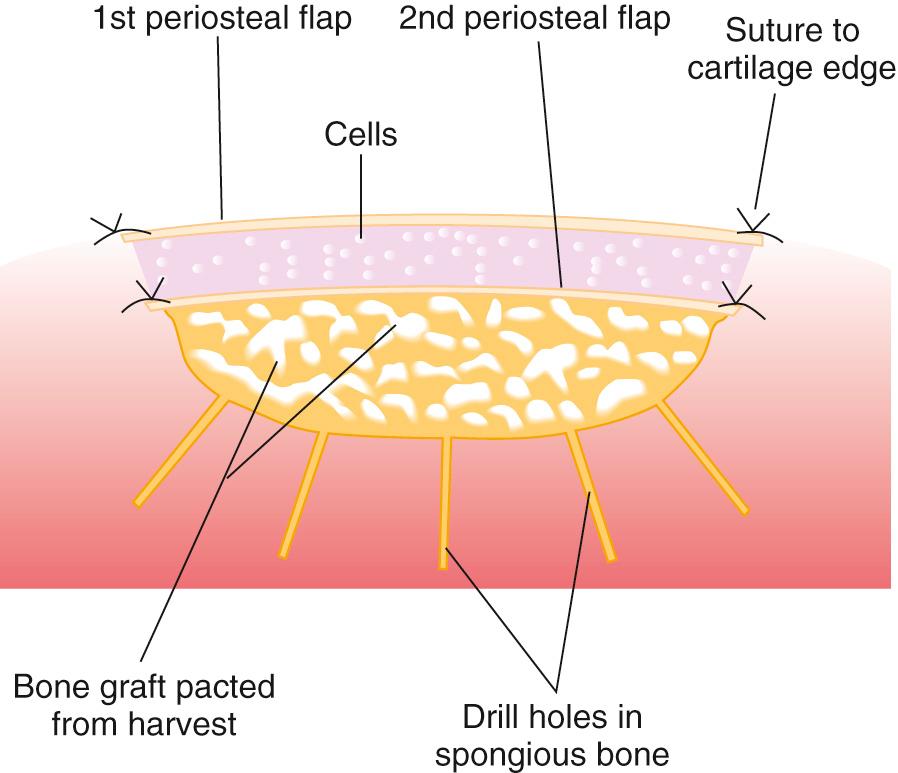
Over the years, it has become obvious when dealing with ACI and concomitant procedures that it is mandatory to create optimal local environmental conditions for the short- and long-term survival of the repair. Malalignment and instability will need corrective surgery for a good result. Procedures such as ACL reconstruction or high tibial osteotomy may be performed at the same time as the biopsy specimen is harvested. Otherwise, they could be done concomitant with the implantation. Pathological mechanics in the joint reduces the chance of successful repair. Patellar lesions are often related to a maltracking or unstable patella, and the patella must thus be realigned or stabilized for good healing. Stabilizing procedures may include anteromedialization and distalization of the tibial tuberosity, lateral release, proximal medial soft-tissue shortening (medial patelofemoral ligament [MPFL] and vastus medialis oblique [VMO]), and trochleaplasty (if it is dysplastic). In patients with trochlear and patellar lesions, especially large and uncontained ones, unloading with ventralization of the tibial tuberosity should be considered. A torn ACL is reconstructed after the cartilage lesion is débrided and covered with periosteum but before the chondrocytes are injected. To unload the transplanted area when a varus or valgus deformity is present, a high tibial or distal femoral osteotomy is performed. When these corrective surgeries are performed, a brace limiting range of motion to 0 to 60 degrees is used postoperatively for 3 weeks, and for the following 3 weeks, range of motion is limited to 0 to 90–120 degrees. In patients with previous total or subtotal meniscectomy, meniscus allograft implantation should be considered.
Become a Clinical Tree membership for Full access and enjoy Unlimited articles
If you are a member. Log in here